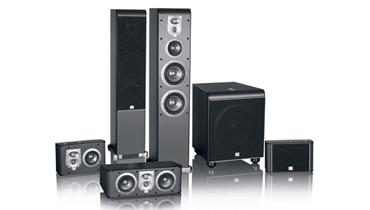JBL ES Series home theater speaker system

| The Short Form |
| $2,395 (as tested) / JBL.COM / 516-255-4525 |
| Snapshot |
| Classic JBL sound quality from towers and a massive sub, complemented by a tonally matched center speaker and surrounds |
| Plus |
| • Loud, natural sound • Clean high-frequency extension • Solid low-frequency extension • Robust construction |
| Minus |
| • Sizable cabinets require a sizable room • Sound may be too bright and forward for some |
| Key Features |
| ES80 ($549 each) • (2) 6-in woofers; 4-in midrange; 3/4-in dome tweeter; 3/4-in ultra-high tweeter; 42 3/4 in high; 46 1/4 lb ES25C ($349) • (2) 5-in woofers; 3/4-in dome tweeter; 3/4-in ultra-high tweeter; 183/4 in wide; 16 3/4 lb ES10 ($349/pair) • 4-in woofer; 3/4-in dome tweeter; 3/4-in ultra-high tweeter; 12 in wide; 8 3/4 lb ES250P ($599) • 12-in woofer; 400-watt amplifier; 19 3/4 x 15 3/4 x 16 7/8 in; 43 lb • Finish: black or cherry |
Having used JBL speakers in recording studios and at home for many years, there's something about them I've always found reassuring. I may or may not have warmed to the voicing of a particular model, but I've always respected what I've heard. So when cartons bearing the familiar orange JBL logo arrived on my doorstep recently, I was eager to check out the company's latest efforts.
The ES Series occupies JBL's upper-middle price range, a hotly contested market where prospective buyers know what sounds good but don't want to spend stupid amounts of money to get it. I unpacked two ES80 towers, an ES25C center speaker, two ES10 surrounds, and an ES250P subwoofer. With their sizable bulk filling my listening room, I expected significant sonic results.
The ES80 tower stands waist-high. Its trapezoidal cabinet, which widens in front and tapers to the rear, looks very stylish. (All of the satellites, and the subwoofer, work the trapezoidal styling angle.) The ES80's five vertical drivers are a pair of 6-inch woofers, a 4-inch midrange, and a module with two 3/4-inch tweeters, one covering the normal high-frequency range and the other covering ultra-high frequencies. This same module appears in the other satellites as well. Two pairs of stout binding posts allow mono- or bi-amping. There's also a rear-firing port.
The ES25C center speaker uses an MTM (midrange/tweeter/midrange) driver configuration, with a pair of 5-inch midranges flanking the tweeter module. Adjusting the ported cabinet's two feet can lower its vertical angle. The ES10 surrounds are direct-firing, with one 4-inch driver and the tweeter module. There are two mounting brackets on the back and two ports on top. Make darn sure the kids don't drop pennies in there - or your car keys.
The ES250P subwoofer sports a front-firing 12-inch driver, a downward-firing port, and an amplifier rated at 400 watts. Its control set provides adjustments for level and crossover frequency (50 to 150 Hz with a 24-dB/octave slope), phase (0° and 180°), and LFE/stereo line inputs. A switch toggles between LFE (for the mono low-frequency-effects channel on Dolby Digital and DTS tracks) and Normal (for a regular stereo input), with the crossover adjustment bypassed when the former setting is selected. All six speakers are faced with removable black grilles.













































